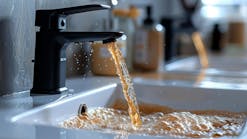Pressure vessels have made their mark on the water treatment industry. From residential treatment systems to commercial systems, pressure vessels are used in water softeners, filters and RO systems. Pressure vessel size and capacity correspond to the application, generally less than 120-gal. capacity in residential applications. Commercial applications require various capacities up to 2,000 gal. Although pressure vessels once installed require little maintenance, proper care must be taken at the receiving, handling and installation stages to avoid damage or failure. This article will provide an overview of some basic pressure vessel handling and installation instructions to ensure quality vessel service for many years.
Receiving
Regardless of its size, all pressure vessels surface must be well protected during shipment. Manufacturers and distributors handle pressure vessel shipments differently, and capacity plays a role as well. They can be protected by being placed horizontally on custom-size cradle skids. It is important to follow manufacturers instructions upon receiving. A pressure vessel with an integral fiberglass base for example, should be placed in a vertical upright position before removing its skid.
Other manufacturers deliver the vessels placed vertically and protected by custom-size cartons. These are easily removed by cutting the straps and removing the cardboard.
Basic Handling Rules
Storing. If you need to store pressure vessels prior to installation, they should be left in either their protective shipping skid, or protective carton until ready to install. Remember, do not roll or slide a pressure vessel on its side.
Do not drop. Never drop a pressure vessel or allow hard impact or abrasion of the pressure vessel from contact with walls, partitions, tools or equipment. Lifting. Lift pressure vessel using a crane or forklift. When using forklift, be sure that the forklift is designed to handle the pressure vessel’s weight at the height the vessel is to be lifted above the floor.
The following are some examples of approved lifting methods.
- Flange - The empty pressure vessel is lifted by placing a user-supplied, webbed nylon reinforced sling, Penco, or rated steel cable around the top of the flange. Sling must be rated at min- imum of 10,000 lbs. When using steel cable, it must have protective coating to prevent scratching of the flange; and
- Lift Strap - Attach a 1/2-in. thick, user-supplied steel lift strap to the top flange, using at least two holes per side. Then connect to a rated eyehook and cable.
Installation
To prevent breakage when installing a pressure vessel with fiberglass tripod or skirt base, commonly delivered on a skid, the following procedure is recommended for handling, unloading and installing this type of vessel.
Stand assembly upright. When the vessel is delivered placed horizontally on a skid, make sure to stand the whole assembly upright. Be sure to exercise all precaution described earlier to protect the pressure vessel from damage. Remove lag bolts. After the assembly is upright, remove the lag bolts, which are holding the skid to the base of the pressure vessel.
Lift. Using one of the approved lifting methods described earlier in the article, lift the vessel from the skid and remove the skid.
Lower. After the skid has been removed, the pressure vessel should be lowered to the floor, leveled and anchored, usually with 3/8-in. lag bolts to the floor. Bolts and anchors are generally supplied by the user. For ease of installation, the manufacturer also suggests that the anchors are located after the vessel is in place.
UV Protection
In outdoor installations, especially ones in warm climates, direct intense sunlight is detrimental to plastics. Therefore a composite pressure vessel should be painted for UV protection. The following seven steps must be taken to ensure proper UV protection.
- Wash the vessel with detergent and water, using a scrub brush. Use the brush over the vessel surface to remove oil and grime;
- Rinse the pressure vessel several times with water to remove soap residue and let it dry;
- Using a clean rag wetted with acetone, rinse the vessel thoroughly with the acetone. Make sure that the rag does not become grimy, and use as much acetone as is practical to per- form a wet rinse over the vessel surface. Be aware that acetone is flammable and it should not be inhaled. Gloves should be used;
- Spray paint or paint with a roller or brush;
- A 100% interior/exterior acrylic latex enamel is recommended. This type of paint has good adhesion and will not chalk. This is a one-step paint with water cleanup. The paint can be pur- chased at any paint store;
- Coat the UV-exposed areas first, for example the top of the pressure vessel and the side, where sun rays directly hit the vessel; and
- When selecting paint, a light-colored, pigmented paint is preferred, white paint is best.
While pressure vessels used in residential or commercial applications will have different installation and maintenance requirements, proper care, handling and installation procedures, as well as common sense will ensure extended vessel service life. wqp


